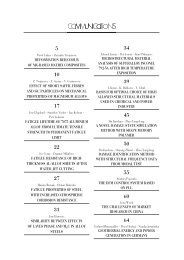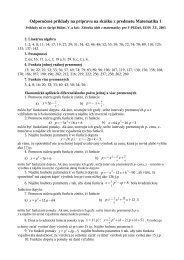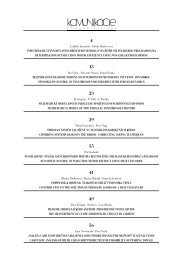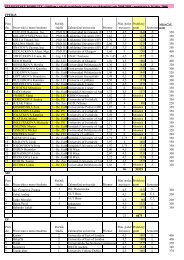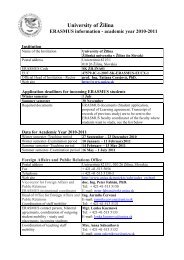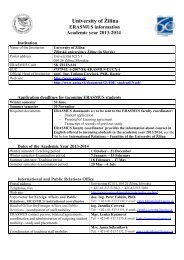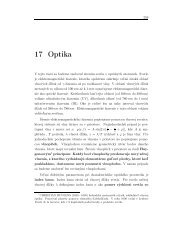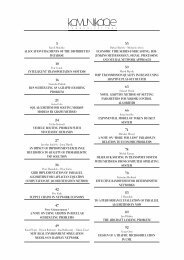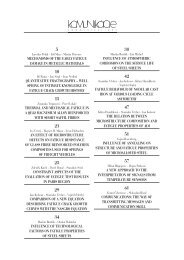simulation of torsion moment at the wheel set of the railway vehicle ...
simulation of torsion moment at the wheel set of the railway vehicle ...
simulation of torsion moment at the wheel set of the railway vehicle ...
You also want an ePaper? Increase the reach of your titles
YUMPU automatically turns print PDFs into web optimized ePapers that Google loves.
REVIEWIvana Olivkova *PASSENGER INFORMATION SYSTEMSIN PUBLIC TRANSPORTThe article deals with establishment <strong>of</strong> passenger inform<strong>at</strong>ion systems which are comprehensive and not limited to one or more individualoper<strong>at</strong>ors or transport modes. The systems should be multi-lingual, disabled adapted, both inside and outside interchanges, and combine st<strong>at</strong>ic(i.e. timetable) and dynamic d<strong>at</strong>a on both public and priv<strong>at</strong>e transport services.1. IntroductionPassenger inform<strong>at</strong>ion systems in transit applic<strong>at</strong>ions refer to<strong>the</strong> use <strong>of</strong> technology to provide travel inform<strong>at</strong>ion to passengersin order to assist <strong>the</strong>ir trip-making or route choice decisions ei<strong>the</strong>rprior to departure or en route. The inform<strong>at</strong>ion provided may varyfrom st<strong>at</strong>ic route, schedule and fare inform<strong>at</strong>ion to real-time <strong>vehicle</strong>loc<strong>at</strong>ion and/or estim<strong>at</strong>ed arrival time. Real-time inform<strong>at</strong>ion canbe <strong>of</strong>fered to passengers when <strong>the</strong> passenger inform<strong>at</strong>ion systemis used in conjunction with GPS systems. Fur<strong>the</strong>rmore, passengerinform<strong>at</strong>ion might be dissemin<strong>at</strong>ed through <strong>the</strong> use <strong>of</strong> transitoper<strong>at</strong>ions s<strong>of</strong>tware such as itinerary planning systems.Passenger inform<strong>at</strong>ion is generally expected to improve <strong>the</strong>quality <strong>of</strong> transit service by improving <strong>the</strong> passenger experience.Passenger inform<strong>at</strong>ion may grant passengers a better sense <strong>of</strong> controlover <strong>the</strong>ir trip-making decisions and/or enable <strong>the</strong>m to take actionto minimize <strong>the</strong>ir waiting times <strong>at</strong> stops, plan <strong>the</strong>ir transfer connectionsand thus reduce <strong>the</strong>ir overall travel time.2. C<strong>at</strong>egories <strong>of</strong> inform<strong>at</strong>ion systems in public transportInform<strong>at</strong>ion systems may be provided in three c<strong>at</strong>egories(Fig. 1):• Pre-trip passenger inform<strong>at</strong>ion systems• In-terminal/wayside inform<strong>at</strong>ion systems• In-<strong>vehicle</strong> inform<strong>at</strong>ion systemsPre-tripPassenger Inform<strong>at</strong>ion Systemsin Public transportIn-terminalVarious factors affect passenger trip-making decisions, includingservice characteristics such as frequency and coverage. Differenttypes <strong>of</strong> inform<strong>at</strong>ion (e.g. st<strong>at</strong>ic or real-time) and differentmethods for accessing th<strong>at</strong> inform<strong>at</strong>ion (e.g. via <strong>the</strong> internet <strong>at</strong>home or in <strong>vehicle</strong> announcements) will likely have different effectson how passengers use different types <strong>of</strong> service (e.g. high frequencyand low frequency). There is a wide variety <strong>of</strong> passenger inform<strong>at</strong>ionsystems th<strong>at</strong> are designed to influence specific passenger behaviorsand decisions. Below, each <strong>of</strong> <strong>the</strong> c<strong>at</strong>egories <strong>of</strong> passengerinform<strong>at</strong>ion systems listed above is discussed.3. Pre-Trip Passenger Inform<strong>at</strong>ion SystemsPre-trip passenger inform<strong>at</strong>ion systems imparts to <strong>the</strong> userinform<strong>at</strong>ion relevant to <strong>the</strong> choices th<strong>at</strong> are made prior to departure.These pre-trip decisions include choice <strong>of</strong> mode, route anddeparture time, thus enabling passengers to choose a course <strong>of</strong>action th<strong>at</strong> best serves <strong>the</strong>ir trip purpose.There are two types <strong>of</strong> pre-trip passenger inform<strong>at</strong>ion:• General Service Inform<strong>at</strong>ion,• Itinerary Planning.In-<strong>vehicle</strong>Fig. 1 C<strong>at</strong>egories <strong>of</strong> passenger inform<strong>at</strong>ion systemsGeneral Service Inform<strong>at</strong>ion systems <strong>of</strong>fer st<strong>at</strong>ic inform<strong>at</strong>ion,such as route, schedule and fare inform<strong>at</strong>ion. This inform<strong>at</strong>ion canbe accessed by phone or by consulting maps and timetables th<strong>at</strong>are posted on <strong>vehicle</strong>s, <strong>at</strong> stops, or on <strong>the</strong> Internet.Itinerary planning systems allow passengers to consider a variety<strong>of</strong> factors such as travel time, walking distance, cost, and number* Ivana OlivkovaInstitut <strong>of</strong> Transport, Faculty <strong>of</strong> Civil Engineering, Technical University <strong>of</strong> Ostrava, Ostrava – Poruba, Czech Republic,E-mail: ivana.olivkova@vsb.czCOMMUNICATIONS 3/2008 ●69



